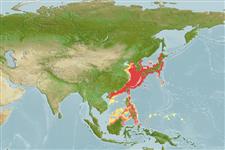分類 / Names
俗名 | 同種異名 | Catalog of Fishes(屬, 種) | ITIS | CoL | WoRMS | Cloffa
Environment: milieu / climate zone / depth range / distribution range
生態學
海洋; 海洋洄游的 (Ref. 51243); 深度上下限 0 - 400 m (Ref. 50550). 溫帶; 8°C - 30°C (Ref. 56557); 49°N - 2°N, 105°E - 155°E (Ref. 54432)
Western Pacific: southern Sakhalin Islands, Sea of Japan and Pacific coasts of Japan, and south to almost Canton/Taiwan; rare records (seems to represent stray fishes) off the coasts of Luzon and Western Mindanao, Philippines and from Manado and Ujung Pandang, Sulawesi, Indonesia (Ref. 189).
西太平洋: 南方的薩哈林島, 日本海與日本的太平洋海岸, 而且幾乎南至廣東/台灣; 稀有的記錄 (似乎代表迷途的魚) 外海的呂宋島與西方菲律賓民答那峨的海岸與從 Manado 與 Ujung Pandang ,印尼蘇拉威西.(參考文獻 189)
Length at first maturity / 大小 / 重量 / 年齡
Maturity: Lm 10.5, range 10 - 11 cm
Max length : 18.0 cm TL 雄魚/尚未辨別雌雄; (Ref. 56527); common length : 14.0 cm TL 雄魚/尚未辨別雌雄; (Ref. 56527); 最大體重: 45.00 g (Ref. 56527); 最大年齡: 4 年 (Ref. 56527)
背棘 (總數): 0; 背的軟條 (總數): 12-14; 臀棘 0; 臀鰭軟條: 13 - 18. Differs very little from the European anchovy (see E. encrasicolus) and can be identified from that description. Of other anchovies found in the southern part of its distribution, only species of Encrasicholina and Stolephorus are of similar appearance, but all have small spine-like pre-pelvic scutes (usually 2 to 7 scutes). Thryssa have compressed bodies and a keel of scutes along belly.
與歐洲的鯷魚 (見 E. encrasicolus) 差異很小而且能從那描述被鑑定。 其他鯷魚發現於它的分布的南部了, Encrasicholina 的唯一種與 Stolephorus 是相似外表, 但是全部有小的像棘一樣的前腹鰭鱗甲.(通常 2 到 7個鱗甲) Thryssa 有扁長形的身體,而且一個鱗甲的龍骨脊沿著腹面。
Occurs in large schools near the surface, mainly in coastal waters but as far out as over 1,000 km from the shore. Tends to move more northward and inshore in spring and summer. Juveniles associate with drifting seaweed (Ref. 12114, 12115). Feeds on copepods, but also on other small crustaceans, molluscan larvae, fish eggs and larvae and diatoms. Marketed fresh and salted, processed into fishmeal and oil (Ref. 12484).
形成大群的魚群接近水表面, 主要在沿岸水域但是遠達超過 1,000 公里距離岸邊。 在春天與夏天傾向移動較北方與沿海地區。 稚魚與漂流的海草聚在一起。 (參考文獻 12114,12115) 吃橈腳類的動物, 也捕食其他的小型甲殼動物,軟體動物的幼生,魚卵與仔魚與矽藻。 在市場上銷售新鮮而鹽醃的, 加工成魚漿或魚油.(參考文獻 12484)
Life cycle and mating behavior
成熟度 | 繁殖 | 產卵場 | 卵 | 孕卵數 | 仔魚
西太平洋: 南方的薩哈林島, 日本海與日本的太平洋海岸, 而且幾乎南至廣東/台灣; 稀有的記錄 (似乎代表迷途的魚) 外海的呂宋島與西方菲律賓民答那峨的海岸與從 Manado 與 Ujung Pandang ,印尼蘇拉威西.(參考文獻 189)
Whitehead, P.J.P., G.J. Nelson and T. Wongratana, 1988. FAO Species Catalogue. Vol. 7. Clupeoid fishes of the world (Suborder Clupeoidei). An annotated and illustrated catalogue of the herrings, sardines, pilchards, sprats, shads, anchovies and wolf-herrings. FAO Fish. Synop. 125(7/2):305-579. Rome: FAO. (Ref. 189)
人類使用
漁業: 高經濟性; 養殖: 商業性; 誘餌: usually
更多資訊
合作者照片Stamps, Coins Misc.聲音神經毒速度泳型鰓區Otoliths腦重體重比眼睛色素
工具
特別的報告
下載 XML
網路資源
Estimates based on models
Preferred temperature (Ref.
123201): 8.1 - 23.3, mean 18.4 °C (based on 139 cells).
Phylogenetic diversity index (Ref.
82804): PD
50 = 0.5020 [Uniqueness, from 0.5 = low to 2.0 = high].
Bayesian length-weight: a=0.00398 (0.00270 - 0.00587), b=3.10 (2.98 - 3.22), in cm total length, based on LWR estimates for this species & Genus-body shape (Ref.
93245).
營養階層 (Ref.
69278): 3.1 ±0.1 se; based on diet studies.
Generation time: 1.1 (1.0 - 1.8) years. Estimated as median ln(3)/K based on 16
growth studies.
回復力 (Ref.
120179): 高度, 族群倍增時間少於 15個月 (K=1.05; tm=1-2; tmax=3).
Prior r = 1.18, 95% CL = 0.78 - 1.76, Based on 7 stock assessments.
Fishing Vulnerability (Ref.
59153): Low vulnerability (23 of 100).
Nutrients (Ref.
124155): Calcium = 148 [56, 380] mg/100g; Iron = 0.698 [0.304, 1.783] mg/100g; Protein = 18.3 [16.8, 19.7] %; Omega3 = 1.57 [0.74, 3.39] g/100g; Selenium = 14.9 [5.6, 40.7] μg/100g; VitaminA = 7.51 [1.30, 42.67] μg/100g; Zinc = 0.939 [0.527, 1.630] mg/100g (wet weight);
